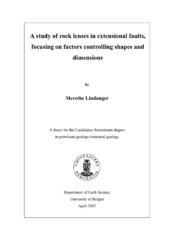| dc.description.abstract | The intension of this work has been to investigate the factors controlling the shapes and dimensions of horses, including the type of mechanism active in their generation and development, position of the horses relative to, or within, the fault core, the amount of displacement across a fault, and lithology. In addition it has been investigated if there is a linear relation between the three dimensions of the horses. Rock lenses are carefully examined and measured in outcrops in three field areas, these being Frøya (island outside mid-Norway), Bornholm (Danish island) and Kilve (southern England), and in analogue plaster of Paris experiments. The rocks hosting the lenses consist of gneisses, nearly unconsolidated sandstones and limestones interbedded with shales, respectively. The data of horses in this study support the proposal that the shapes and dimensions of horses are not completely arbitrary, but dependent on several factors. Horses occurring in fault cores tend to be thicker relative to length as compared to horses occurring in damage zones. Also the type of mechanism active in the generation of the horses is important for their shapes, where asperity bifurcation horses tend to be relatively thicker than horses generated as a result of segment splaying and amalgamation. Lithology seems to be a controlling factor upon the maximum sizes of the horses, where the largest horses are observed in ‘strong’ rocks, such as in gneiss and limestone interbedded with shales, whereas only relatively smaller horses are recorded in ‘weak’ rocks, such as nearly unconsolidated sandstones. The amount of displacement across a fault is another factor influencing the shape of the horses, where horses in faults with several meters vertical displacement tend to be thicker relative to length as compared to horses occurring in faults with less vertical displacement. The average horse in this study has a length that is ten times the thickness. | en_US |
